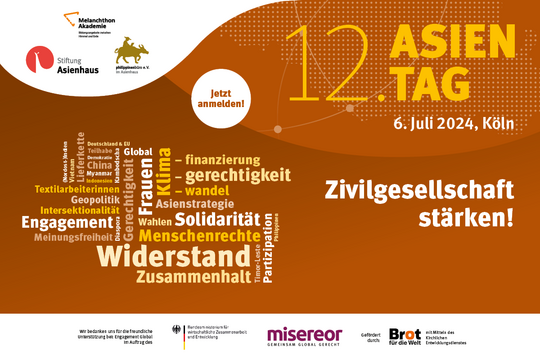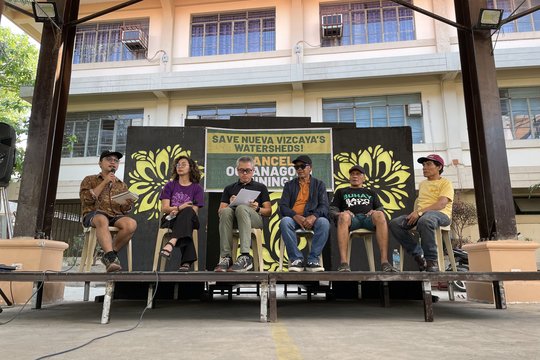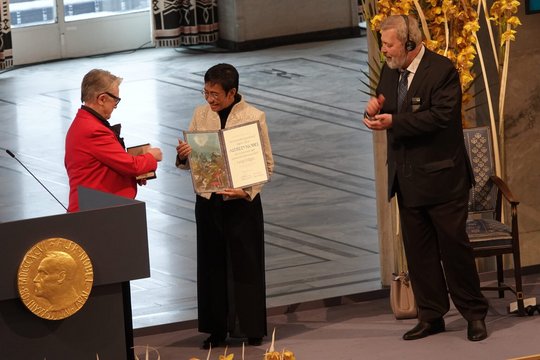written by Dietrich Harth
Biographical note
José Rizal was 23 years old when he completed his study of medicine in Madrid and shortly afterwards passed another exam with distinction at the Faculty of Philosophy of the Central University in the Spanish capital. After his final exams he stayed in Paris, Heidelberg and Berlin from 1885 to 1887 to be trained as an ophthalmic surgeon by the best doctors. A few years before these trips, he had begun writing a novel in Spanish about the conditions in his homeland, which he was able to publish in 1887 under the biblical title Noli me tangere (Don't touch me) in a Berlin publishing house.
The ophthalmologist and writer José Rizal was born in 1861 as the seventh of eleven children in a multi-ethnic family on the Philippine island of Luzon. Since the early 20th century, the Philippine governments year after year celebrate Rizal as their national hero. The date of his death, 30 December 1896, is one of the most important holidays in the country. Rizal died on this day near the capital Manila at the age of 35, shot by a firing squad commanded by Spanish officers.
Considered as dangerous rebel
Among the alleged high treason offences of which he was accused by a Spanish court martial was the publication of the novel Noli me tangere, the plot of which Rizal had continued in a second part. This sequel, published in 1891 under the title El Filibusterismo (The Reign of Greed), could also not be printed in Spain or the Philippines, which is why Rizal had to resort to a publisher in Ghent, Belgium. For in the Philippines, which had suffered more than 300 years of Spanish colonial rule, the young doctor and writer was considered a dangerous rebel both by the colonial administration and by the monastic orders controlling the educational institutions, although he, like Mahatma Gandhi, had emphatically spoken out against violence. Instead, he demanded sweeping reforms in the spirit of decolonisation, including Philippine representation in the Madrid parliament, fair distribution of land, independence of the judiciary, recognition of human dignity and cultural self-determination. In his novels, the author took the liberty of satirically ridiculing the cruelties of the colonialist abuse of power and religion.
Encounter with the German-speaking world
Even Rizal's membership in the highly respected Berliner Gesellschaft für Anthropologie, Ethnologie und Urgeschichte (Berlin Society for Anthropology, Ethnology and Prehistory) founded by the ‘Pope of medicine’ Rudolf Virchow (1821-1902), the ethnologist Adolf Bastian (1826-1905) and others could not protect him. On the contrary, his Spanish opponents denounced him after his admission to the Berlin Society as an agent of Bismarck. Since the German chancellor Bismarck was in dispute with Spain over the ownership of some Pacific islands at the time, this was a dangerous slander.

A linguistically gifted traveller
Rizal was a restless traveller who visited the capitals of Europe – Madrid, Paris, London, Berlin, Vienna, Brussels and Rome – like an inquisitive ethnographer, looking around not only in the local libraries and hospitals, but also in schools, museums, zoological as well as botanical gardens and – not least – in the ethnographical collections. He wanted, he wrote to his family in Calamba, to seek out all “that instructs me, so that I can introduce what I learn here to the Philippines." (Comisión Nacional del Centenario de J. Rizal (1961): Correspondencia epistolar, Vol. 1. Manila, p. 259.) As is well known, the study of foreign cultures – if it is to trigger learning processes in the observer – presupposes a good knowledge of the languages spoken in these cultures. In this respect, Rizal was extremely gifted. Language barriers did not stop him, as evidenced not only by his wide-ranging readings, but also by his polyglot correspondence and his numerous translations. He had “made surprisingly rapid progress in German”, he wrote home from Heidelberg in the spring of 1886, “and talked with the Germans in alto aleman or High German.” (Correspondencia epistolar, p. 235) Correspondencia epistolar, p. 235.In the summer of the same year, he posted the bilingual (Spanish and Tagalog) book of an arithmetician at the Heidelberg post office, together with an accompanying letter written in German Kurrent handwriting, to an address in Leitmeritz, Bohemia. The recipient was Ferdinand Blumentritt (1853 -1913), a professor at the local grammar school, who was probably the best expert on the Philippines at the time.
Correspondence between Rizal and Blumentritt
Blumentritt explored the Philippines from books and from the distance, but he too was a polyglot scholar and had an extensive network of correspondents, including Filipino and European informants. Anyone who wanted to broaden their knowledge about the history and cartography of the archipelago, about the numerous ethnic groups and languages that existed there, or about Spanish colonial history, sooner or later sought contact with him. In his accompanying letter, Rizal mentioned Blumentritt's knowledge of Tagalog as the reason, but he specially sought the friendship of the famous Philippinist. And he was successful, as the latter not only sent him some of his own publications but provided him also with precious letters of recommendation, which were intended to introduce Rizal to the most respected anthropologists and ethnologists of the time. The correspondence between Rizal and Blumentritt, mostly written in German, occasionally in Spanish, and dealing with historiographical, ethnological, philological and political questions, lasted uninterruptedly for ten years: from the first Heidelberg letter dated 31 July 1886 to the last farewell written on death row in Manila on 29 December 1896. This corpus of letters is a treasure trove not only for those interested in cultural history and ethnolinguistic; it also contains rich material on the colonialist brutalism that was on the rise in the last third of the 19th century.
Anthropological ruthlessness
In Heidelberg, Rizal had continued his specialist training at the eye clinic of the University and now set off on a journey to Berlin in August 1886, where he wanted to continue his medical education. He arrived in the German capital in November of the same year, but met two German travellers to the Philippines on the way. In Leipzig, he had contact with Hans Meyer (1858-1929) from the dynasty around Meyers Konversations-Lexikon. This Meyer had just published a book entitled Eine Weltreise. Plaudereien aus einer zweijährigen Erdumseglung (A voyage around the world. Chats from a two-year circumnavigation of the earth), in which, among other things, a visit to one of the Philippine indigenous peoples (Igorot) was mentioned. In the appendix, Meyer had printed a study by Rudolf Virchow which referred to skull measurements, the objects of which had reached Berlin from the Philippines under highly dubious circumstances. Since Rizal had received the book as a gift from the author, he was well prepared when, sometime later, he had to take a stand against the disparagements of the Filipino “indios” by the pen of a Spanish apologist of colonialism. In his racist publications, the Spaniard cited the results of Virchow's craniometric analyses as alleged evidence of a congenital lack of intelligence among Filipinos.
Grave robbers “in the service of science”
At the end of October 1886 Rizal then stopped in Dresden and met the director of the Royal Zoological and Anthropological-Ethnological Museum there, the primatologist and traveller to the Philippines Adolf Bernhard Meyer (1840-1911). Both the Dresden and Leipzig Meyer (who were not related to each other) had excelled as grave robbers during their stays in the Philippines and openly boasted of these “adventures”. Their prey were the skulls and bones of the indigenous mountain peoples in the Philippines, and they did not shy away from desecrating the resting place of the dead in order to enrich anthropogenetic hypotheses with their goods shipped to Berlin “in the service of science.”

Fighting colonial exhibitions in Madrid
Rizal was no friend of the so-called skin and bone anthropology, but now he directed his anger against an event of which he had heard about during his trip to Berlin. The Spanish government was planning a Philippine exhibition in Madrid in the style of the “Völkerschauen” popular with the colonial powers at the time. One of the attractions of this exhibition was to be the presentation of the very indigenous peoples whose bones and skulls were stored in Virchow's Berlin study and in the evidence rooms of the Königliches Museum für Völkerkunde (Royal Museum of Ethnology) set up by Adolf Bastian, today a difficult legacy of the Ethnological Museum displayed in the Humboldt Forum. Even before his arrival in Berlin, Rizal encouraged his Filipino friends in Barcelona and Madrid to publicly fight by all means the Philippine show, the organisation of which was assisted by the all-powerful clergy in the Philippines.
Rizal’s ambivalent stance towards “Völkerkunde”
As far as the “Völkerkunde”, closely linked to colonialism, was concerned, Rizal was quite ambivalent towards it. On the one hand he ironized its claim to be able to methodically lift the veil of the foreign cultures; on the other hand, he appreciated the knowledge about his Philippine homeland collected by European ethnographers and “explorers” preserved in archives and museums. “Thanks to the German scholars,” he wrote to Blumentritt from Berlin in the spring of 1887, “we are getting accurate news about our people, and when everything at home will be destroyed, we will have to go to Germany [...,] to visit the museums, to leaf through the German books; it is sad, but it must be done!” (Comisión Nacional del Centenario de José Rizal (1961): Cartas entre Rizal y el profesor Fernando Blumentritt. Manila, p. 126.)
The destruction of autochthonous traditions
The destruction to which this resigned remark alludes has - as one might perhaps assume - less to do with the fact of the typhoons that periodically strike the islands or with the eruptions of the Pacific Ring of Fire that pulsates underground. Rather, Rizal was thinking here of the destruction of autochthonous traditions pushed forward by the colonial regime with the active participation of the missionaries and the accompanying expropriation of a historical narrative that is part of the collective self-assurance. In one of his numerous essays critical of colonialism, Filipinas dentro de cien años (The Philippines one hundred years from now, 1889/90), he dealt very pointedly with the erasure of one's own cultural memory by the foreign invaders. In the eyes of the Catholic missionaries, this was probably a “pious” work, since it was supposed to cure the “island peoples” of the belief in the devil. But in reality, this work was in the service of naked exploitation and, as Rizal's dedication to the ‘Fatherland’ in his novel Noli me tangere says, infected the peoples with a ‘social cancer’ that eats away at the moral foundations of coexistence.
Rizal's battle against the colonialist ‘cancer’
With his novel, Rizal wanted – as indicated in the dedication – to uncover the causes of the ‘cancer’ scourge and unmask those responsible for it. But that was not all: he was also interested in making his compatriots aware of the images and life traces of their own history that had been withheld from them. To this end, during a stay in Paris in 1889, when the French were celebrating hundred years of revolution, he drew up detailed plans for the establishment of an empirical Philippine science that would explore the archipelago from every conceivable angle, opening up time and space.
A commentary to ideologically distorted claims
At the same time, in the form of an ongoing commentary, he contradicted the errors and ideologically distorted claims about the pre-colonial life of the “island peoples” that had been spread in a chronicle of the Philippines, published in 1609 and written by Antonio de Morga, a Spanish official of the colonial administration. Blumentritt had drawn his attention to that rare book and recommended that he should study the Philippine literature available in the Royal Library in Berlin.
Rizal not only took note of the missionary Philippine chronicles, he also immersed himself in the reports of Antonio Pigafetta (Magellan's chronicler), Adelbert von Chamisso, Fedor Jagor and numerous other world travellers who had written about the archipelago from their own experience. Wilhelm von Humboldt's studies on the Kawi language and “the diversity of human language building” encouraged him to make his own language comparisons and grammar attempts dedicated to the Tagalog; through Theodor Waitzen's Anthropologie der Naturvölker (Anthropology of indigenous peoples) he became acquainted with Alexander von Humboldt's theory of civilisation.

A future Philippine library
He wanted to translate some of these into Tagalog, acquired the books that were important to him and urged his fellow campaigners to work on the foundations for a future Philippine library. He also did not forget the significance of material culture and sent selected ethnographica (e.g. a device for cutting rice plants) to Bastian's Museum of Ethnology (Ident. No. I C 18672). He dreamed of a school set up to the measure of German educational standards, where he would work side by side with Blumentritt to prepare Filipino youth for entry into the “modern world”.
“I am sure,” he wrote from Brussels to Leitmeritz, “all the boys, the best in the country will come to us. Blumentritt, Rizal will remain like Goethe and Schiller, like Horatius and Vergilius, like the two Humboldts [in the] memory of the Philippine people.” (Cartas entre Rizal y el profesor Fernando Blumentritt, p. 638)
Conclusion
The fortuitous circumstances of history would have it that the literary intellectual Rizal, while living in bondage as an exile, was held responsible for the revolutionary uprising of the Filipinos that broke out in the summer of 1896 and hence was killed by the Spanish Crown. According to official political opinion, Rizal is regarded the martyr who not only inspired the revolution but whose idolized figure as national hero is also used to perpetuate the ritual process of national identity formation in the Philippines. It is all the more tragic that he – “the perfect anti-hero” (Nick Joaquin) – has been largely forgotten as an astute critic of colonialism.
Copyright for all translations in this essay from Spanish and German sources: D. Harth.
Bibliographical Note
José Rizal (1996): The Social Cancer. A Complete Version of Noli me tangere from the Spanish of José Rizal by Charles E. Derbyshire. Quezon City, Philippines
José Rizal (1997): The Reign of Greed. A Complete English Version of El Filibusterismo from the Spanish of José Rizal by Charles E. Derbyshire. Quezon City, Philippines
Antonio de Morga (1891): Sucesos de las islas Filipinas, nuevamente sacada á luz y anotada por José Rizal y precedida de un prólogo del Prof. Fernando Blumentritt with the Paris publishing house Librería de Garnier Hermanos.
José Rizal (1961): Correspondencia epistolar, Vol. 1. Manila: Comisión Nacional del Centenario de J. Rizal.
Cartas entre Rizal y el profesor Fernando Blumentritt (1961). Manila: Comisión Nacional del Centenario de José Rizal
José Rizal (1961): Filipinas dentro de cien años (1889/1890). In Escritos políticos e históricos. Manila: Comisión Nacional del Centenario de José Rizal, pp. 136-165.
Dietrich Harth (2021): José Rizals Kampf um Leben und Tod. Facetten einer kolonialismuskritischen Biografie. Heidelberg (online: https://doi.org/10.11588/heibooks.839)
Further reading and research
Mapping Philippine Material Culture: This digital humanities project of the Philippine Studies at SOAS London is a visual inventory of Philippine objects dating to the mid-20th century which are in holdings of museums and private collections outside of the Philippines. The open access online inventory gathers photographic and textual information about these objects and aggregates the data in an easy-to- navigate, all-in-one sortable portal.










